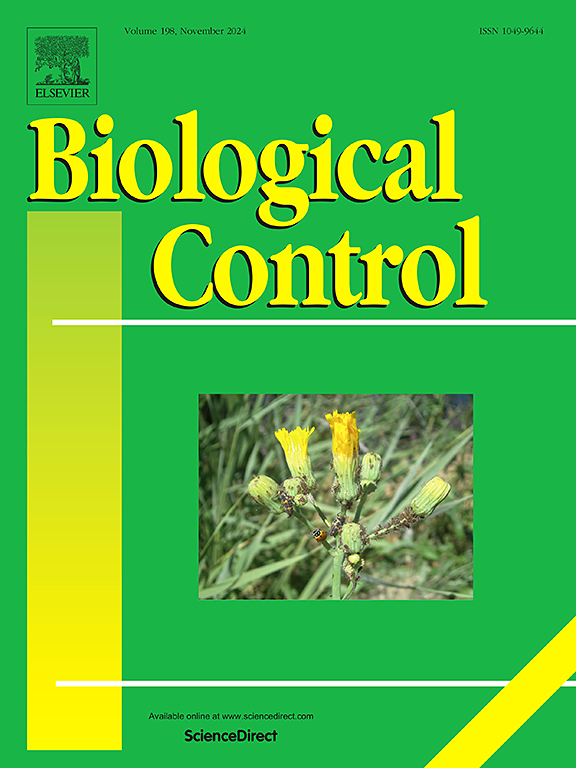Larvicidal activity against Phenolia (Lasiodites) picta (Coleoptera: Nitidulidae) on jujube (Zizyphus jujuba Miller var. inermis Rehder) and the improvement of high-quality fruit production using Bacillus licheniformis PR2
IF 3.4
2区 农林科学
Q2 BIOTECHNOLOGY & APPLIED MICROBIOLOGY
引用次数: 0
Abstract
The increasing consumption and demand of jujube fruits has accelerated production over the recent past. However, the aspects of eco-friendly strategies for pest control and high-quality fruit production are becoming more important to combat the impending dangers of repeated chemicals use in orchard management. This study identified for the first time, the sap beetle (Phenolia (Lasiodites) picta) larvae (based on mitochondrial DNA barcode sequencing), as the major insect pest causing damage in jujube fruits in Korea. The study investigated the insecticidal potential of cuticle-degrading enzymes from Bacillus licheniformis PR2 against P. picta larvae, and the enhancement of fruit quality and yield, through phytohormone production, ammonia production and phosphate solubilizing properties of the bacterium. Bacillus licheniformis PR2 produced chitinase and protease and caused larval mortalities of 55.56 % and 68.89 % when treated with the bacterial broth culture and crude enzyme fraction, respectively. The insecticidal activity in both treatments were characterized by deep cuticle fissures with swollen/depressed surfaces and loss of sensilla. Field application of B. licheniformis PR2 effectively controlled P. picta larvae in jujube orchard during active feeding period as they moved from fruit-to-fruit which reduced the damage and premature fruit-drop. Moreover, B. licheniformis PR2 produced indole-3-acetic acid (IAA) and gibberellic acid (GA) phytohormones, and increased the soil concentration of nitrogen and phosphorus concentration in the soil. The application of B. licheniformis PR2 in jujube orchard increased the chlorophyll content/photosynthetic activity, fruit yield, fruit characteristics (such as length, diameter and fruit weight) and the organoleptic properties (such as the Ca content, firmness and sugar concentration) of jujube fruits, compared to the control and conventional treatment. Thus, we demonstrate that B. licheniformis PR2 can be a viable alternative to chemical pesticides and fertilizers and could enhance the eco-friendly and sustainable production of high-quality jujube fruits to meet the increasing demands.
利用地衣芽孢杆菌PR2对枣(Zizyphus jujuba Miller var. inermis Rehder)的杀虫活性及改良优质果实生产
近年来,红枣的消费和需求不断增加,加速了红枣的生产。然而,为了对抗果园管理中重复使用化学品所带来的迫在眉睫的危险,害虫控制和高质量水果生产方面的生态友好战略变得越来越重要。本研究首次确定了韩国枣果主要危害害虫是树液甲虫(Phenolia (Lasiodites) picta)幼虫(基于线粒体DNA条形码测序)。本研究研究了地衣芽孢杆菌PR2表皮降解酶对picta幼虫的杀虫潜力,以及该细菌通过产生植物激素、产生氨和增磷特性提高果实品质和产量的作用。地衣芽孢杆菌PR2产生几丁质酶和蛋白酶,其致死率分别为55.56%和68.89%。两种处理的杀虫活性均表现为表皮深裂、表面肿胀/凹陷和感觉器官丧失。田间施用地衣双翅虫PR2能有效地控制枣园果皮蠹幼虫在采食期在果实间的迁移,减少了果皮蠹的危害和过早落果。地衣芽孢杆菌PR2能产生吲哚-3-乙酸(IAA)和赤霉素(GA)植物激素,提高土壤氮磷浓度。与对照和常规处理相比,在枣园施用地衣芽孢杆菌(B. licheniformis PR2)提高了枣园果实的叶绿素含量/光合活性、果实产量、果实性状(如果长、果径和果重)和感官性状(如钙含量、硬度和糖浓度)。因此,我们认为地衣芽孢杆菌PR2可以作为化学农药和化肥的可行替代品,促进红枣果实的生态和可持续生产,以满足日益增长的需求。
本文章由计算机程序翻译,如有差异,请以英文原文为准。
求助全文
约1分钟内获得全文
求助全文
来源期刊

Biological Control
生物-昆虫学
CiteScore
7.40
自引率
7.10%
发文量
220
审稿时长
63 days
期刊介绍:
Biological control is an environmentally sound and effective means of reducing or mitigating pests and pest effects through the use of natural enemies. The aim of Biological Control is to promote this science and technology through publication of original research articles and reviews of research and theory. The journal devotes a section to reports on biotechnologies dealing with the elucidation and use of genes or gene products for the enhancement of biological control agents.
The journal encompasses biological control of viral, microbial, nematode, insect, mite, weed, and vertebrate pests in agriculture, aquatic, forest, natural resource, stored product, and urban environments. Biological control of arthropod pests of human and domestic animals is also included. Ecological, molecular, and biotechnological approaches to the understanding of biological control are welcome.
 求助内容:
求助内容: 应助结果提醒方式:
应助结果提醒方式:


